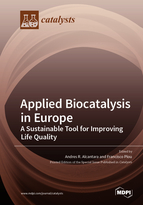Applied Biocatalysis in Europe: A Sustainable Tool for Improving Life Quality
A special issue of Catalysts (ISSN 2073-4344). This special issue belongs to the section "Biocatalysis".
Deadline for manuscript submissions: closed (31 August 2020) | Viewed by 44295
Special Issue Editors
Interests: enzymatic synthesis of drugs and bioactive compounds; sustainable processes; biocatalyst upgrading; pharmaceutical industry; organic chemistry; pharmaceutical chemistry
Special Issues, Collections and Topics in MDPI journals
Special Issue Information
Dear Colleagues,
Applied Biocatalysis and Biotransformation, that is, the use of enzymes and whole-cell systems in manufacturing processes for synthetic purposes, has been experiencing a clear boom in recent years, which has led to the start of the so-called “fourth wave”. In fact, the latest advances in bioinformatics, system biology, process intensification, and, in particular, enzyme-directed evolution (encouraged by the 2018 Nobel Prize awarded to F. Arnold) are widening the range of the efficacy of biocatalysts and accelerating the rate at which new enzymes are becoming available, even for activities not previously known. Moreover, xenobiology, the insertion of non-canonical amino acids into protein sequences, is creating fascinating new possibilities for the preparation of biocatalysts with improved properties.
Traditionally, European scientists have been very actively involved in different aspects of Applied Biocatalysis. This Special Issue aims to gather contributions from European research groups, in the form of either original research articles or up-to-date reviews, to exemplify recent advances in this area. This includes, but is not restricted to, the discovery of new enzymatic activities, the chemical or genetic modification of known biocatalysts for further application in the development of commodities and fine chemicals, and the implementation of biocatalyzed protocols using enzymes (in any stage) and cells to increase the sustainability of synthetic procedures.
Prof. Andres R Alcantara
Prof. Francisco J. Plou
Guest Editors
Manuscript Submission Information
Manuscripts should be submitted online at www.mdpi.com by registering and logging in to this website. Once you are registered, click here to go to the submission form. Manuscripts can be submitted until the deadline. All submissions that pass pre-check are peer-reviewed. Accepted papers will be published continuously in the journal (as soon as accepted) and will be listed together on the special issue website. Research articles, review articles as well as short communications are invited. For planned papers, a title and short abstract (about 100 words) can be sent to the Editorial Office for announcement on this website.
Submitted manuscripts should not have been published previously, nor be under consideration for publication elsewhere (except conference proceedings papers). All manuscripts are thoroughly refereed through a single-blind peer-review process. A guide for authors and other relevant information for submission of manuscripts is available on the Instructions for Authors page. Catalysts is an international peer-reviewed open access monthly journal published by MDPI.
Please visit the Instructions for Authors page before submitting a manuscript. The Article Processing Charge (APC) for publication in this open access journal is 2700 CHF (Swiss Francs). Submitted papers should be well formatted and use good English. Authors may use MDPI's English editing service prior to publication or during author revisions.
Keywords
- Biocatalysis
- Biotransformations
- Sustainable processes
- Enzyme engineering
- Metagenomics
- White biotechnology







